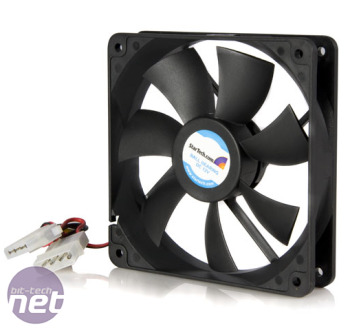
The Big Air Cooling Investigation
Active air cooling is the bread and butter of PC cooling and it can be found in action on everything from the most lowly net top, to insane top-of-the-range gaming monsters.It’s amazing then that there is so little known for sure about air cooling; ask how you should best set up your case fans on the bit-tech forums and you’ll probably get around thirty different answers, each person swearing blind that his or her method is definitely the best set up.
Part of the problem of course is that there are so many variables involved - what will work for one case may not work for another and different fans have different strengths and weaknesses too.
Add to this the effect that ambient air temperature, air pressure and humidity can have on cooling efficacy and it’s clear that the reason little concrete evidence about air cooling exists is because it’s a terribly difficult subject to be concrete on.
Its lucky then that we here at bit-tech have never shied away from doing something because ‘it’ll be a bit difficult’ - it’s why you like us right? Well, that and our good looks I suppose.
Here, then, is our big air cooling investigation where we’ll take an in depth look at the question of how best to air cool your PC. We’ll try to cover the nagging little questions that every PC builder faces such as how many fans you should have, where you should put them and which way they should face.
We’ll also try to put the whole positive pressure vs. negative pressure cooling argument to bed and even take a quick look at whether the traditional front to back cooling arrangement of most desktop PCs is actually the most efficient method of cooling.

There are a few caveats that we should really explain (and that you really should read) before we get going though. For a start it’d be patently impossible for us to draw solid conclusion that are relevant to each and every one of you - we’ve done our best to make our setup as general and generic as possible, so you should be able to take something away from this, but we’re sorry if we don’t cover your particular case setup or fan arrangement in this investigation. You’re all smart people though so you should be able to take the findings from this investigation away and apply them to your own set up in some form.
Also, noise. We get asked over and over to do noise testing with a decibel meter but it’s not going to happen; not while we’re here, doing testing in this office with a construction site next door and a tube line running beneath us. It’s arguably also less relevant here as things like build quality and materials will affect how loud a given case is, potentially more so than the number of fans housed within it. It's safe to assume though that adding extra fans to a case produces extra noise.
With that said, let’s begin.

MSI MPG Velox 100R Chassis Review
October 14 2021 | 15:04









Want to comment? Please log in.